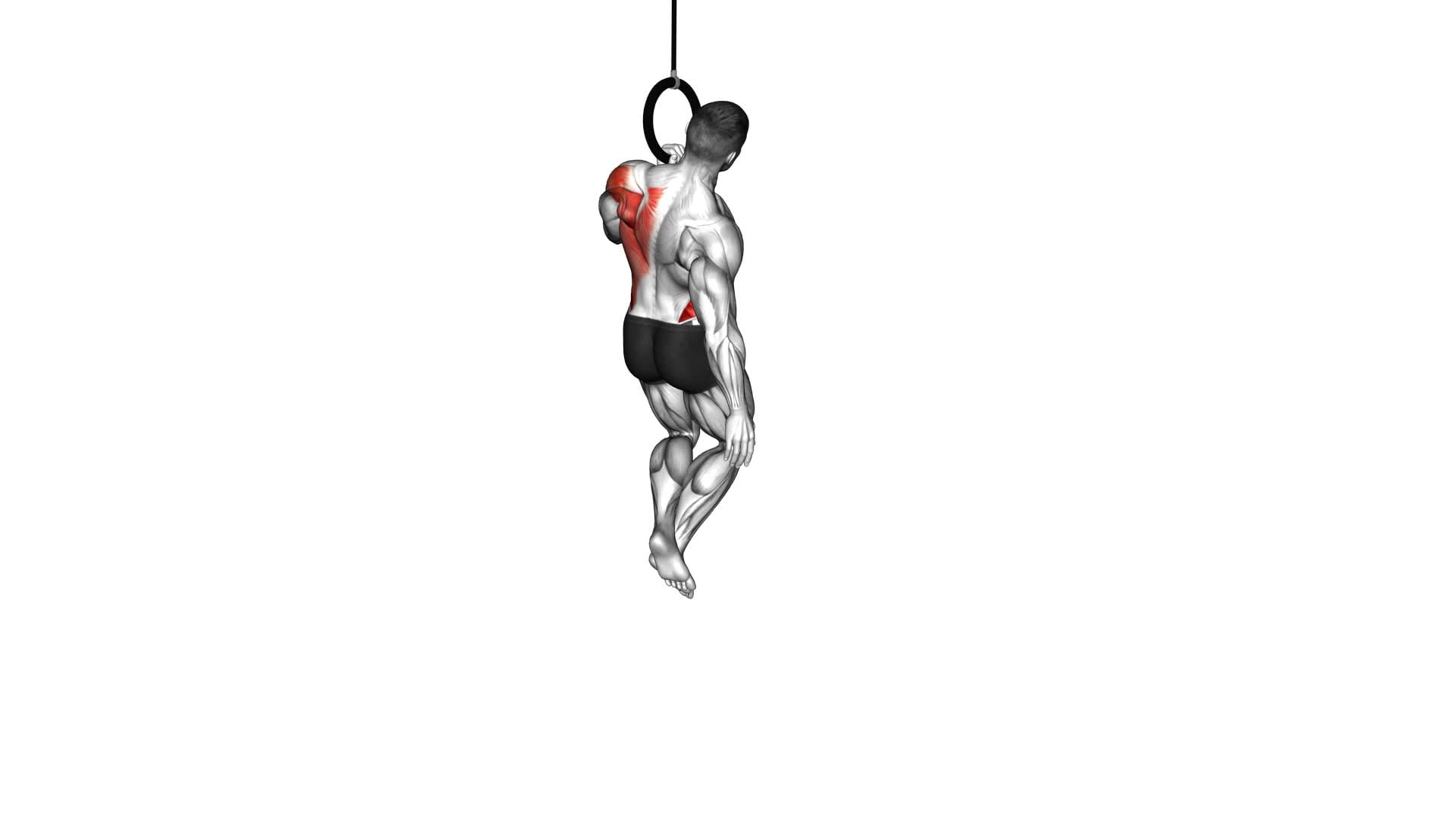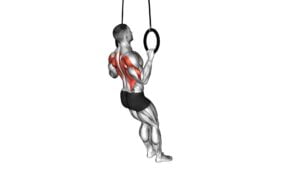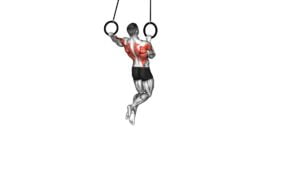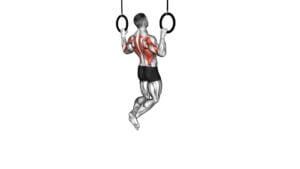Ring One Arm Pull-up (male) – Video Exercise Guide & Tips

Are you looking to take your upper body strength to the next level? Then the ring one arm pull-up is the exercise for you.
Watch This Exercise Video
In this video exercise guide, we'll show you the proper form and technique to master this challenging move. Whether you're a beginner or an advanced athlete, we've got progression exercises and advanced variations to suit your level.
Get ready to push your limits and achieve impressive results with our tips and expert advice. Let's get started!
Key Takeaways
- Targets multiple muscle groups
- Increases upper body strength
- Engages stabilizer muscles
- Enhances grip strength
Benefits of the Ring One Arm Pull-up
The Ring One Arm Pull-up offers numerous benefits for individuals looking to build upper body strength and improve their overall fitness levels. This challenging exercise targets multiple muscle groups, resulting in increased upper body strength and improved grip strength.
Performing the Ring One Arm Pull-up requires significant engagement from the muscles in your arms, back, and shoulders. As you pull yourself up using only one arm, you're effectively working these muscles in isolation, leading to increased strength and muscle definition. Additionally, the instability of the rings forces your body to engage more stabilizer muscles, making this exercise even more effective in developing overall upper body strength.
Furthermore, the Ring One Arm Pull-up is an excellent exercise for improving grip strength. The rings provide an unstable surface, requiring you to grip tightly to maintain control and stability. This constant tension on your hands and forearms helps to strengthen your grip, which can have benefits in various activities such as weightlifting, rock climbing, and even everyday tasks that require a strong grip.
Proper Form and Technique
How can you ensure proper form and technique while performing the Ring One Arm Pull-up? Proper form and technique are crucial for maximizing the benefits and reducing the risk of injury during this challenging exercise.
To start, it's important to avoid common mistakes such as using momentum or swinging your body to complete the movement. Instead, focus on maintaining control and stability throughout the entire range of motion.
Proper muscle activation is key to performing the Ring One Arm Pull-up correctly. Begin by engaging your core and lats, as these muscles play a significant role in the exercise. As you pull yourself up, concentrate on activating your back muscles to initiate the movement. Avoid relying solely on your biceps, as this can lead to imbalances and potential injury.
Additionally, it's crucial to maintain proper body alignment throughout the exercise. Keep your body straight, avoiding any excessive arching or rounding of the back. This will help distribute the workload evenly and prevent strain on the lower back.
Remember to always warm up before attempting the Ring One Arm Pull-up and start with a weight that allows you to maintain good form. Gradually increase the difficulty as you become more comfortable and confident with the exercise.
Progression Exercises for Beginners
To progress as a beginner, you can start with exercises that focus on building strength and stability in your upper body and core. Here are some progression exercises that can help you improve your abilities:
- Assisted Pull-ups: Use a resistance band or a partner to assist you in performing pull-ups. This modification will help you build the necessary strength to eventually do them on your own.
- Negative Pull-ups: Start at the top of the pull-up position and slowly lower yourself down. This eccentric movement helps develop the muscles needed for a full pull-up.
- Ring Rows: Set up rings at chest height and perform rows by pulling your chest towards the rings. This exercise targets similar muscles as pull-ups but is easier to control and modify.
- Plank Variations: Planks are great for building core stability, which is essential for pull-ups. Start with a basic plank and progress to side planks and other variations to challenge your stability further.
When performing these exercises, it's important to keep a few common mistakes in mind. Avoid using momentum or swinging your body during pull-ups, as this reduces the effectiveness of the exercise. Additionally, maintain proper form and engage your core throughout the movements to maximize the benefits.
Advanced Variations and Challenges
For an added challenge, incorporate weighted pull-ups into your training routine to further increase upper body strength and progress towards the ring one-arm pull-up. Weighted pull-ups involve attaching a weight to your body using a dip belt, weight vest, or holding a dumbbell between your feet. Start with a weight that allows you to perform 6-8 reps with good form and gradually increase the weight as you get stronger.
To continue your advanced progressions, you can also try using different grip variations such as the narrow supine grip or the wide pronated grip. These variations target different muscles and can help you develop a well-rounded upper body strength.
When attempting advanced variations like the ring one-arm pull-up, it's important to be aware of common mistakes. These include relying too much on momentum, using improper form, and neglecting the necessary progressions. It's crucial to focus on controlled and strict movements to avoid injury and maximize the effectiveness of the exercise.
In the next section, we'll discuss tips for injury prevention and recovery, which is essential when engaging in challenging exercises like the ring one-arm pull-up. Taking care of your body and allowing proper rest and recovery will help you stay healthy and continue progressing towards your fitness goals.
Tips for Injury Prevention and Recovery
Are you wondering what steps you can take to prevent injuries and aid in your recovery process? When it comes to performing advanced exercises like the Ring One Arm Pull-up, it's important to prioritize injury prevention and have effective recovery strategies in place. Here are some tips to help you stay injury-free and recover quickly:
- Warm-up: Always start your workout with a proper warm-up routine to increase blood flow to your muscles and prepare your body for the intense exercise. This can include dynamic stretches, mobility exercises, and light cardio.
- Proper form: Pay close attention to your form while performing the Ring One Arm Pull-up. Maintaining proper technique not only maximizes the effectiveness of the exercise but also reduces the risk of injury. Engage your core, retract your scapula, and focus on smooth and controlled movements.
- Gradual progression: Avoid rushing into advanced variations without first mastering the basics. Gradually increase the intensity and difficulty of your workouts to give your body enough time to adapt and avoid overexertion.
- Recovery and rest: Allow your body enough time to rest and recover between workouts. This includes getting enough sleep, incorporating active recovery exercises, and listening to your body's cues for rest days. Proper recovery helps prevent muscle imbalances, overtraining, and reduces the risk of injury.
Frequently Asked Questions
How Long Does It Take to Master the Ring One Arm Pull-Up?
To master the ring one arm pull-up, it takes time and dedication. It's a difficult exercise that requires strength, stability, and control.
You'll need to focus on building up your upper body and core strength, as well as improving your grip. Alternatives for difficult exercises like this can include assisted one arm pull-ups or using a resistance band.
Progress in training for advanced moves like these can vary from person to person, but with consistent practice, you can achieve your goals.
What Muscles Does the Ring One Arm Pull-Up Target?
The ring one arm pull-up is a challenging exercise that targets several key muscles in your upper body. By focusing on one arm at a time, you engage your latissimus dorsi, biceps, and forearm muscles in a unique way. This exercise not only builds strength and muscle definition but also improves your grip strength and stability.
To add variety, you can try different variations such as the assisted one arm pull-up or the one arm chin-up.
Can Women Also Perform the Ring One Arm Pull-Up?
Yes, women can build enough upper body strength to perform a ring one arm pull-up. With dedication and proper training, anyone can achieve this challenging exercise.
There are no specific training techniques exclusively for women, as the same principles apply to both genders. Consistency, progressive overload, and a well-rounded workout routine that targets the back, arms, and core will help you develop the necessary strength for a ring one arm pull-up.
Are There Any Modifications or Alternatives for Individuals Who Cannot Perform the Ring One Arm Pull-Up?
If you're unable to do the ring one arm pull-up, don't worry, there are modifications and alternatives available.
There are exercises like assisted one arm pull-ups using resistance bands or a partner to help you.
Another option is doing negative one arm pull-ups, where you focus on the lowering phase of the movement.
These modifications will still challenge your muscles and help you progress towards doing the full one arm pull-up.
How Often Should I Include the Ring One Arm Pull-Up in My Workout Routine?
To properly incorporate the ring one arm pull-up into your workout routine, it's important to progress gradually. Start by mastering regular pull-ups and strengthening your grip.
Then, practice using one arm at a time, gradually reducing the assistance from your other arm. Be mindful of common mistakes such as using momentum or not engaging your core.
Aim to include this exercise in your routine 2-3 times a week for optimal results.
Conclusion
In conclusion, the ring one arm pull-up is an impressive exercise that offers numerous benefits, including increased strength and muscle development.
By mastering the proper form and technique, beginners can gradually progress to more advanced variations and challenges.
It's important to prioritize injury prevention and recovery by listening to your body and seeking professional guidance if needed.
Incorporating this exercise into your fitness routine can significantly enhance your upper body strength and overall fitness level.

Author
Years ago, the spark of my life’s passion ignited in my mind the moment I stepped into the local gym for the first time. The inaugural bead of perspiration, the initial endeavor, the very first surge of endorphins, and a sense of pride that washed over me post-workout marked the beginning of my deep-seated interest in strength sports, fitness, and sports nutrition. This very curiosity blossomed rapidly into a profound fascination, propelling me to earn a Master’s degree in Physical Education from the Academy of Physical Education in Krakow, followed by a Sports Manager diploma from the Jagiellonian University. My journey of growth led me to gain more specialized qualifications, such as being a certified personal trainer with a focus on sports dietetics, a lifeguard, and an instructor for wellness and corrective gymnastics. Theoretical knowledge paired seamlessly with practical experience, reinforcing my belief that the transformation of individuals under my guidance was also a reflection of my personal growth. This belief holds true even today. Each day, I strive to push the boundaries and explore new realms. These realms gently elevate me to greater heights. The unique combination of passion for my field and the continuous quest for growth fuels my drive to break new ground.







